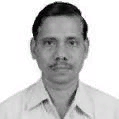
B. Gopala Krishna
Work place: National Remote Sensing Centre, Indian Space Research Organization, Hyderabad, India.
E-mail: swamy_gp@nrsc.gov.in
Website:
Research Interests: Data Structures and Algorithms, Image Processing, Image Manipulation, Image Compression, Computer Architecture and Organization
Biography
B.Gopala Krishna, received M.Sc.Tech (Electronics) from Andhra University, Visakhapatnam, and M.Tech (Electronics) from IIT, Kharagpur with a specialization in Satellite Communications and Remote Sensing. Currently he is Deputy Director of DPPA&WAA at NRSC, ISRO, Hyderabad. He has more than 170 publications to his credit in National and International journals. He is a life member of various technical societies viz. INCA, ISRS, IMSA, ISG, ISSE and ASCI. His research interests include digital photogrammetry and mapping, geometrical data processing for remotely sensed data, planetary data processing, and stereo image analysis.
Author Articles
Generation of Analysis Ready Data for Indian Resourcesat Sensors and its Implementation in Cloud Platform
By Thara Nair Akshay Singh E.Venkateswarlu G.P.Swamy Vinod M Bothale B. Gopala Krishna
DOI: https://doi.org/10.5815/ijigsp.2019.06.02, Pub. Date: 8 Jun. 2019
The introduction of remote sensing techniques had lead us into a new race of advanced data processing applications. The analysis ready data is also a part of it which is generated at the producer end to facilitate its user to directly go on to the application part. This paper highlights the generation, processing and cloud applications of the Analysis Ready Data (ARD) using ISRO's Satellites Resourcesat-2 and Resourcesat-2A's LISS-3 sensor data. The proposed work includes use of terrain corrected data for generating Radiance, Top of Atmosphere (ToA) Reflectance, Normalized Difference Vegetation Index (NDVI), Enhanced Vegetation Index (EVI) and Time series analysis with pixel level Quality Assessment (QA) for all the generated data products. A graphical user interface has been developed for online ordering of data by the user. This paper also highlights the implementation of the developed application in cloud platform using the cloud computing model, Platform as a Service (PaaS).This facilitates the users to generate the ARD products from any device, facilitating a quick and all time available transmission rate for the customers.
[...] Read more.Scene based Non-uniformity Correction for Optical Remote Sensing Imagery
By Lolith Gopan E.Venkateswarlu Thara Nair G.P.Swamy B. Gopala Krishna
DOI: https://doi.org/10.5815/ijigsp.2017.12.06, Pub. Date: 8 Dec. 2017
In this work, we propose and evaluate different scene based methods for non-uniformity corrections for optical remote sensing data sets. These methods can be used to correct or refine the existing radiometric calibrations, thereby improving the image quality. The performance of each algorithm against different datasets are analyzed and a quantitative comparison of different quality parameters viz. entropy, correlation coefficient, signal to noise ratio, peak signal to noise ratio and structural similarity index are carried out to recommend the best method for each scene. For a given data set, the selected method depends on the severity, type of terrain it covered, etc.
[...] Read more.Estimation of NIIRS Incorporating an Automated Relative Edge Response Method
By Pranav V E.Venkateswarlu Thara Nair G.P.Swamy B. Gopala Krishna
DOI: https://doi.org/10.5815/ijigsp.2017.11.04, Pub. Date: 8 Nov. 2017
The quality of remote sensing satellite images are expressed in terms of ground sample distance, modular transfer function, signal to noise ratio and National Imagery Interpretability Rating Scale (NIIRS) by user community. The proposed system estimates NIIRS of an image, by incorporating a new automated method to calculate the Relative Edge Response (RER). The prominent edges which contribute the most for the estimation of RER are uniquely extracted with a combined application of certain filters and morphological operators. RER is calculated from both horizontal and vertical edges separately and the geometric mean is considered as the final result. Later applying the estimated RER along with other parameters, the system returns the NIIRS value of the input image. This work has proved the possible implementation of automated techniques to estimate the NIIRS from images and specifics in the metafile contents of imagery.
[...] Read more.Spatiotemporal Data Fusion using Dictionary Learning and Temporal Edge Primitives
By J. Malleswara Rao C. V. Rao A. Senthil Kumar B. Gopala Krishna V. K. Dadhwal
DOI: https://doi.org/10.5815/ijigsp.2015.10.06, Pub. Date: 8 Sep. 2015
Technological limitations restrict to acquire an image at high spatial and high temporal resolutions with space borne global sensors. In this paper, we propose a novel technique to create such images at ground-based data processing system. The Resourcesat-2 is one of the Indian Space Research Organization (ISRO) global missions and it carries Linear Imaging and Self-Scanning Sensors (LISS III and LISS IV) and an Advanced Wide-Field Sensor (AWiFS). The spatial resolution of LISS III is 23.5 m and that of AWiFS is 56 m. The temporal resolution of LISS III is 24 days and that of AWiFS is 5 days. Objective of the paper is to create a synthetic LISS III image at 23.5 m spatial and 5-day temporal resolutions. A synthetic LISS III image at time tk is created from an AWiFS image at time tk and a single AWiFS–LISS III image pair at time t0 which is acquired before or after the prediction time tk , here t0≠tk. The proposed method involves three phases. The first is super resolution phase. In this phase, two transition images are obtained for the time t0 and tk by improving AWiFS spatial resolution. The second is high pass modulation phase. In this phase, the high frequency details which are obtained in the difference of LISS III image and the transition image of time t0 are proportionally injected into the transition image at time tk. In composition of multi-temporal images of different spatial resolutions, spurious spatial discontinuities are inevitable. In the third phase, these spurious discontinuities are identified and smoothed with the spatial-profile-averaging method. The proposed method achieves better prediction accuracy when compared to the state-of-the art techniques.
[...] Read more.Other Articles
Subscribe to receive issue release notifications and newsletters from MECS Press journals